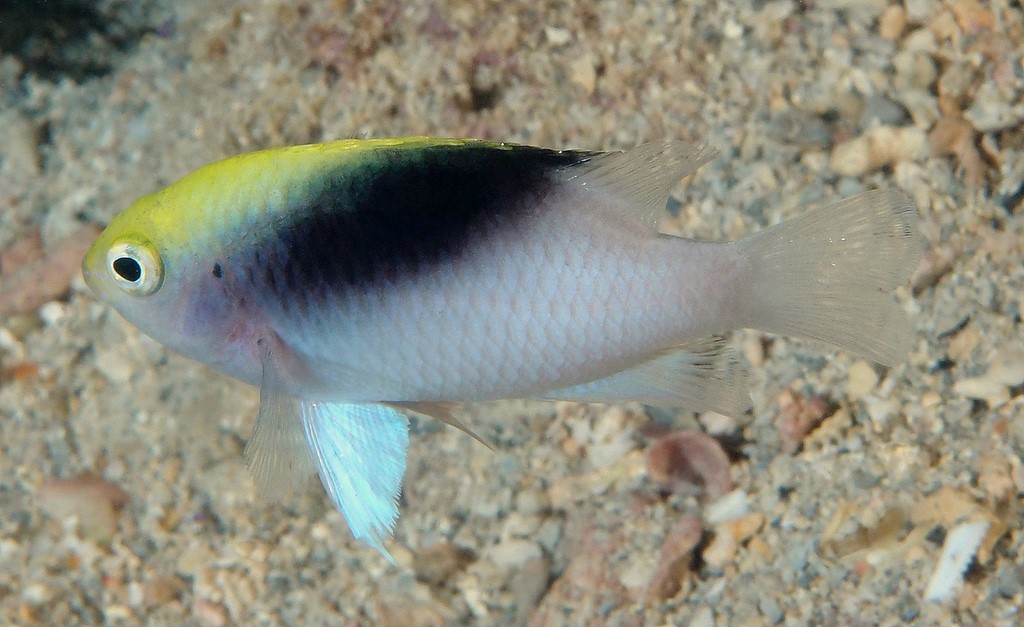CHRYSIPTERA ROLLANDI - (WHITLEY, 1961)
Actinopterygii (Gigaclass) > Actinopteri (Class) > Teleostei (Subclass) > Blenniiformes (Order) > Pomacentridae (Family) > Pomacentrinae (Subfamily) > Chrysiptera (Genus)
Demoiselle de Rolland, Demoiselle tricolore, Blue-head damsel, Blue-headed damsel, Bluehead demoiselle, Rolland's demoiselle, 罗氏金翅雀鲷, 羅氏金翅雀鯛,
Description
Épines dorsales (Total) : 13; Rayons mous dorsaux (Total) : 10-11; Épines anales 2; Rayons mous anaux : 12-13. Il y a deux variations de couleur avec la Demoiselle de Rolland. Une avec un ligne/liseré horizontal bleu juste au dessus de l'oeil et qui rejoint la base de la nageoire dorsale, et l'autre qui a une tête jaunâtre. Taille maximale : 7.5 cm TL. Profondeur : 2 - 35 m.
Etymologie
Chrysiptera : du Grec ancien, chrysos ou khrusos = or (métal de couleur jaune), doré + du Grec, pteron ou pteroeis = nageoire, aile, ailé.
rollandi : le Dr. René Catala a demandé, si le poisson était nouveau, de le dédicacer à son ami Monsieur Jean Rolland, qui l'a beaucoup aidé.
Description originale : Chromis rollandi Whitley, 1961 - Localité type : Baie des Citrons, Nouméa, Nouvelle-Calédonie.
Biologie
Ce poisson se nourrit principalement de zooplancton. Il n'y a pas de dimorphisme sexuel.
Synonymes
Chromis rollandi (Whitley, 1961)
Glyphidodontops rollandi (Whitley, 1961)
------------------------
Description
Dorsal spines (total): 13; Dorsal soft rays (total): 10-11; Anal spines: 2; Anal soft rays: 12-13. Dorsal part of the head and anterior portion of the back dark brown with blue streaks, creamy white below. Front body and head dark blue-brown, grey-white rear body. long white pelvic fins, younger specimen with fine blue lines on head. Juveniles with dark spot in dorsal fin. Specimen from the East Coral sea have a yellow snout forehead. Max length: 7.5 cm TL. Depth range: 2 - 35 m.
Etymology
Chrysiptera: from Greek, chrysos = golden + from Greek, pteron = fin, wing. Referring to yellow caudal fin and/or yellowish pectoral and ventral fins of Glyphisodon azureus Cuvier, 1830 (= Chrysiptera cyanea (Quoy & Gaimard, 1825)).
rollandi: Dr. Rene Catala asked me to dedicate the species, if new, to his friend. Mr. Jean Rolland, who helps him very much, and this I have much pleasure in doing.
Original description: Chromis rollandi Whitley, 1961 - Type locality: caught near the intake pipe of the aquarium at Baie des Citrons, Nouméa, New Caledonia, southwestern Pacific.
Distribution
Indo-West Pacific: Andaman Sea, Indonesia, Philippines, Papua New Guinea, Palau, Australia to Solomon Islands and New Caledonia.
Biology
Adults occur singly or in small groups in lagoons, harbors, and outer reef slopes. Found among corals and coral rubble. Feed mainly on zooplankton. Oviparous, distinct pairing during breeding. Eggs are demersal and adhere to the substrate. Males guard and aerate the eggs.
Demoiselle de Rolland, Demoiselle tricolore, Blue-head damsel, Blue-headed damsel, Bluehead demoiselle, Rolland's demoiselle, 罗氏金翅雀鲷, 羅氏金翅雀鯛,
Description
Épines dorsales (Total) : 13; Rayons mous dorsaux (Total) : 10-11; Épines anales 2; Rayons mous anaux : 12-13. Il y a deux variations de couleur avec la Demoiselle de Rolland. Une avec un ligne/liseré horizontal bleu juste au dessus de l'oeil et qui rejoint la base de la nageoire dorsale, et l'autre qui a une tête jaunâtre. Taille maximale : 7.5 cm TL. Profondeur : 2 - 35 m.
Etymologie
Chrysiptera : du Grec ancien, chrysos ou khrusos = or (métal de couleur jaune), doré + du Grec, pteron ou pteroeis = nageoire, aile, ailé.
rollandi : le Dr. René Catala a demandé, si le poisson était nouveau, de le dédicacer à son ami Monsieur Jean Rolland, qui l'a beaucoup aidé.
Description originale : Chromis rollandi Whitley, 1961 - Localité type : Baie des Citrons, Nouméa, Nouvelle-Calédonie.
Biologie
Ce poisson se nourrit principalement de zooplancton. Il n'y a pas de dimorphisme sexuel.
Synonymes
Chromis rollandi (Whitley, 1961)
Glyphidodontops rollandi (Whitley, 1961)
------------------------
Description
Dorsal spines (total): 13; Dorsal soft rays (total): 10-11; Anal spines: 2; Anal soft rays: 12-13. Dorsal part of the head and anterior portion of the back dark brown with blue streaks, creamy white below. Front body and head dark blue-brown, grey-white rear body. long white pelvic fins, younger specimen with fine blue lines on head. Juveniles with dark spot in dorsal fin. Specimen from the East Coral sea have a yellow snout forehead. Max length: 7.5 cm TL. Depth range: 2 - 35 m.
Etymology
Chrysiptera: from Greek, chrysos = golden + from Greek, pteron = fin, wing. Referring to yellow caudal fin and/or yellowish pectoral and ventral fins of Glyphisodon azureus Cuvier, 1830 (= Chrysiptera cyanea (Quoy & Gaimard, 1825)).
rollandi: Dr. Rene Catala asked me to dedicate the species, if new, to his friend. Mr. Jean Rolland, who helps him very much, and this I have much pleasure in doing.
Original description: Chromis rollandi Whitley, 1961 - Type locality: caught near the intake pipe of the aquarium at Baie des Citrons, Nouméa, New Caledonia, southwestern Pacific.
Distribution
Indo-West Pacific: Andaman Sea, Indonesia, Philippines, Papua New Guinea, Palau, Australia to Solomon Islands and New Caledonia.
Biology
Adults occur singly or in small groups in lagoons, harbors, and outer reef slopes. Found among corals and coral rubble. Feed mainly on zooplankton. Oviparous, distinct pairing during breeding. Eggs are demersal and adhere to the substrate. Males guard and aerate the eggs.
